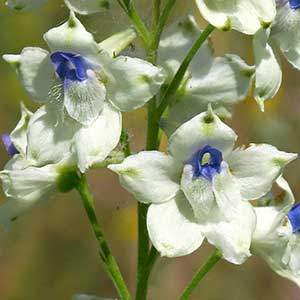Delphinium nuttallii subsp. ochroleucum
(synonym of Delphinium leucophaeum)
Delphinium recurvatum
pale larkspur, white rock larkspur
Byron larkspur, recurved larkspur, valley larkspur
30-60 cm.
(18-)30-50(-85) cm;
base reddish, glabrous.
blade round to pentagonal, 1-4 × 1.5-6 cm, nearly glabrous; ultimate lobes 3-11, width 3-15 mm (basal), 1-10 mm (cauline).
(8-)10-25(-47)-flowered, narrowly pyramidal;
pedicel ± spreading, (0.5-)1.5-4(-6) cm, nearly glabrous;
bracteoles 3-8(-18) mm from flowers, green, sometimes margins white, lanceolate to linear, 3-5(-8) mm, nearly glabrous.
sepals white or light yellow, spurs 9-11 mm;
lower petal blades 4-6 mm.
sepals light to sky blue (becoming bluer upon drying), puberulent, lateral sepals reflexed, 11-16 × 5-7(-9) mm, spurs straight to gently upcurved, ascending 0-30° above horizontal, 10-15(-18) mm;
lower petal blades elevated, ± exposing stamens, 5-8 mm, clefts 0.5-2.5 mm;
hairs mostly centered on inner lobes near base of cleft, white.
8-21 mm, 2.2-3 times longer than wide, puberulent.
seed coat cells brick-shaped, cell margins undulate, surfaces roughened.
= 16.
= 16.
Delphinium nuttallii subsp. ochroleucum
Delphinium recurvatum
Of conservation concern.
The range of morphologic features of Delphinium nuttallii subsp. ochroleucum (D. leucophaeum) is almost completely encompassed within that of D. nuttallii subsp. nuttallii. Sepal color is the only feature consistently separating the two subspecies. Were it not for the fact that any given population typically has plants of only one flower color, a rank of forma would be more appropriate.
(Discussion copyrighted by Flora of North America; reprinted with permission.)
Of conservation concern.
Delphinium recurvatum has a very restricted distribution in the Central (especially San Joaquin) Valley. This species was probably much more common in the past; most of its habitat has been converted into irrigated croplands. Delphinium recurvatum grows in poorly drained, alkaline soils on valley floors.
Hybrids are known between Delphinium recurvatum and D. gypsophilum, D. hesperium, D. parryi, and D. variegatum. Delphinium recurvatum is most likely to be confused with D. gypsophilum or D. hesperium subsp. pallescens. Distinguishing features are found in discussions of those taxa.
(Discussion copyrighted by Flora of North America; reprinted with permission.)


